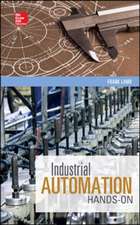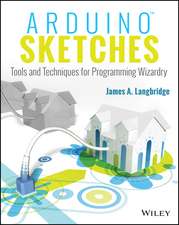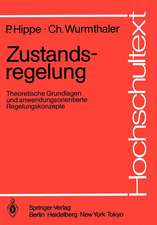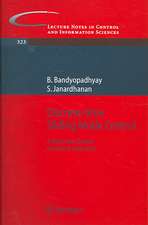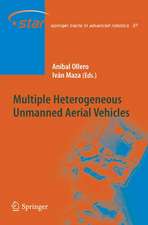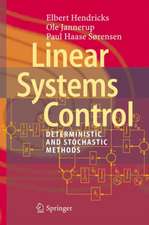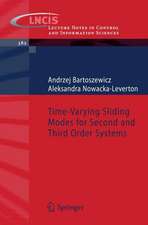Windup in Control: Its Effects and Their Prevention: Advances in Industrial Control
Autor Peter Hippeen Limba Engleză Hardback – 13 apr 2006
Peter Hippe presents antiwindup solutions for stable and unstable single-input-single-output and multiple-input-multiple-output (MIMO) systems. The solutions use only standard tools for the investigation of linear systems – state equations, transfer functions, etc. Less rigorous solutions which guarantee improved performance but without strict proof of stability are also demonstrated. Maintenance of MIMO system directionality and bumpless transfer are included and the developments in control methods are always supplemented by easily repeated numerical examples.
Academics doing control-related research and engineers working in the process industries will find this book an extremely useful overview of systematic windup prevention for all kinds of systems. It also has valuable insights to offer the graduate student of control.
| Toate formatele și edițiile | Preț | Express |
|---|---|---|
| Paperback (1) | 1109.78 lei 6-8 săpt. | |
| SPRINGER LONDON – 21 oct 2010 | 1109.78 lei 6-8 săpt. | |
| Hardback (1) | 1225.79 lei 6-8 săpt. | |
| SPRINGER LONDON – 13 apr 2006 | 1225.79 lei 6-8 săpt. |
Din seria Advances in Industrial Control
- 15%
 Preț: 643.34 lei
Preț: 643.34 lei - 23%
 Preț: 582.63 lei
Preț: 582.63 lei - 18%
 Preț: 783.98 lei
Preț: 783.98 lei - 18%
 Preț: 947.35 lei
Preț: 947.35 lei - 20%
 Preț: 568.24 lei
Preț: 568.24 lei - 15%
 Preț: 643.16 lei
Preț: 643.16 lei - 18%
 Preț: 899.21 lei
Preț: 899.21 lei - 18%
 Preț: 891.33 lei
Preț: 891.33 lei - 18%
 Preț: 740.57 lei
Preț: 740.57 lei - 18%
 Preț: 961.23 lei
Preț: 961.23 lei - 18%
 Preț: 955.08 lei
Preț: 955.08 lei - 15%
 Preț: 645.28 lei
Preț: 645.28 lei - 15%
 Preț: 638.43 lei
Preț: 638.43 lei - 18%
 Preț: 901.11 lei
Preț: 901.11 lei - 18%
 Preț: 1410.94 lei
Preț: 1410.94 lei - 18%
 Preț: 728.91 lei
Preț: 728.91 lei - 20%
 Preț: 1003.78 lei
Preț: 1003.78 lei - 18%
 Preț: 947.35 lei
Preț: 947.35 lei - 15%
 Preț: 643.34 lei
Preț: 643.34 lei - 15%
 Preț: 654.30 lei
Preț: 654.30 lei - 18%
 Preț: 950.52 lei
Preț: 950.52 lei - 15%
 Preț: 644.30 lei
Preț: 644.30 lei - 18%
 Preț: 1393.09 lei
Preț: 1393.09 lei - 18%
 Preț: 950.21 lei
Preț: 950.21 lei - 18%
 Preț: 949.90 lei
Preț: 949.90 lei - 18%
 Preț: 949.42 lei
Preț: 949.42 lei - 18%
 Preț: 950.52 lei
Preț: 950.52 lei - 18%
 Preț: 1113.71 lei
Preț: 1113.71 lei - 15%
 Preț: 650.04 lei
Preț: 650.04 lei - 15%
 Preț: 644.95 lei
Preț: 644.95 lei - 18%
 Preț: 950.33 lei
Preț: 950.33 lei - 18%
 Preț: 948.61 lei
Preț: 948.61 lei - 18%
 Preț: 1112.60 lei
Preț: 1112.60 lei - 15%
 Preț: 644.63 lei
Preț: 644.63 lei - 18%
 Preț: 953.20 lei
Preț: 953.20 lei - 18%
 Preț: 945.62 lei
Preț: 945.62 lei - 15%
 Preț: 640.88 lei
Preț: 640.88 lei - 15%
 Preț: 640.88 lei
Preț: 640.88 lei - 20%
 Preț: 650.92 lei
Preț: 650.92 lei - 18%
 Preț: 1112.60 lei
Preț: 1112.60 lei - 20%
 Preț: 998.36 lei
Preț: 998.36 lei - 15%
 Preț: 643.34 lei
Preț: 643.34 lei - 18%
 Preț: 948.92 lei
Preț: 948.92 lei - 18%
 Preț: 1381.43 lei
Preț: 1381.43 lei - 15%
 Preț: 651.51 lei
Preț: 651.51 lei - 15%
 Preț: 647.08 lei
Preț: 647.08 lei - 20%
 Preț: 563.66 lei
Preț: 563.66 lei - 18%
 Preț: 992.64 lei
Preț: 992.64 lei
Preț: 1225.79 lei
Preț vechi: 1494.86 lei
-18% Nou
Puncte Express: 1839
Preț estimativ în valută:
234.59€ • 244.01$ • 193.66£
234.59€ • 244.01$ • 193.66£
Carte tipărită la comandă
Livrare economică 14-28 aprilie
Preluare comenzi: 021 569.72.76
Specificații
ISBN-13: 9781846283222
ISBN-10: 1846283221
Pagini: 336
Ilustrații: XVIII, 314 p. 139 illus.
Dimensiuni: 155 x 235 x 22 mm
Greutate: 0.68 kg
Ediția:2006
Editura: SPRINGER LONDON
Colecția Springer
Seria Advances in Industrial Control
Locul publicării:London, United Kingdom
ISBN-10: 1846283221
Pagini: 336
Ilustrații: XVIII, 314 p. 139 illus.
Dimensiuni: 155 x 235 x 22 mm
Greutate: 0.68 kg
Ediția:2006
Editura: SPRINGER LONDON
Colecția Springer
Seria Advances in Industrial Control
Locul publicării:London, United Kingdom
Public țintă
ResearchCuprins
Undesired Effects of Input Saturation.- Prevention of Controller Windup.- Prevention of Plant Windup in Stable Systems.- Further Methods for the Prevention of Windup.- Prevention of Plant Windup in Stable and Unstable Single Input Systems.- Prevention of Windup in Multivariable Systems.- Additional Rate Constraints.- Bumpless Transfer.- Résumé and Concluding Discussions.- Design of Observer-based Controllers.
Recenzii
From the reviews:
Peter Hippe has done a nice job with his book. The central thesis is clear and provides a nice framework for the methods he emphasizes. His book contains many helpful examples that demonstrate the approaches and make them easy to emulate. In addition, the selection of topics provides a sturdy bridge to other methodologies that address control with input saturation. For example, Hippe's dichotomy betwen controller windup and plant windup is related to the distinction between the effectiveness of "static" and "dynamic" anti-windup compensation which can be determined by assessing the feasibility of a set of LMIs. This provides a link to the growing body of work on the use of LMIs to solve control design problems in the presence of input saturation. Hippe's nonlinear trajectory generator may inspire the reader to consult other reference governor ideas in the literature, eventually leading to the vast body of work on model predictive control. Finally, the description of Buhler's nonlinear cascaded control idea may inspire the reader to digest papers on nested saturation control.
Regardless of the saturation control problem one faces, Peter Hippe's book is an enjoyable read that will help to develop an intuitive feel for and better understanding of control with input saturation.
IEEE Transactions on Automatic Control 53 (2008) 1976 – 1977 (Reviewer: Andrew R. Teel)
Peter Hippe has done a nice job with his book. The central thesis is clear and provides a nice framework for the methods he emphasizes. His book contains many helpful examples that demonstrate the approaches and make them easy to emulate. In addition, the selection of topics provides a sturdy bridge to other methodologies that address control with input saturation. For example, Hippe's dichotomy betwen controller windup and plant windup is related to the distinction between the effectiveness of "static" and "dynamic" anti-windup compensation which can be determined by assessing the feasibility of a set of LMIs. This provides a link to the growing body of work on the use of LMIs to solve control design problems in the presence of input saturation. Hippe's nonlinear trajectory generator may inspire the reader to consult other reference governor ideas in the literature, eventually leading to the vast body of work on model predictive control. Finally, the description of Buhler's nonlinear cascaded control idea may inspire the reader to digest papers on nested saturation control.
Regardless of the saturation control problem one faces, Peter Hippe's book is an enjoyable read that will help to develop an intuitive feel for and better understanding of control with input saturation.
IEEE Transactions on Automatic Control 53 (2008) 1976 – 1977 (Reviewer: Andrew R. Teel)
Textul de pe ultima copertă
Actuator saturation is probably the most frequent nonlinearity encountered in control applications. Input saturation leads to controller windup, removable by structural modification during compensator realization and plant windup which calls for additional dynamics.
Peter Hippe presents solutions to the windup prevention problem for stable and unstable single-input-single-output and multiple-input-multiple-output (MIMO) systems. The solutions use only standard tools for the investigation of linear systems – state equations, transfer functions, etc. The stability tests are based on well-known criteria for loops consisting of a linear part with isolated sector-type nonlinearity. Less rigorous "engineering solutions" which guarantee improved performance but without strict proof of stability are also demonstrated.
MIMO systems in which the behaviour of controlled variables is decoupled require specific input vectors and so also suffer problems of directionality when their input signals saturate. This can have extremely deleterious consequences for closed-loop behaviour. Windup in Control offers an exact solution to this directionality problem for stable and unstable systems. The methods laid out in this survey also integrate solutions for applications with rate-constrained actuators and for bumpless transfer from manual to automatic during system start-up or in override control. Developments in control methods are always supplemented by easily repeated numerical examples.
Academics doing control-related research in electronics, mechanics, or mechatronics and engineers working in the process industries will find this book an extremely useful overview of systematic windup prevention for all kinds of systems. It also has valuable insights to offer the graduate student of control.
Advances in Industrial Control aims to report and encourage the transfer of technology in control engineering. The rapiddevelopment of control technology has an impact on all areas of the control discipline. The series offers an opportunity for researchers to present an extended exposition of new work in all aspects of industrial control.
Peter Hippe presents solutions to the windup prevention problem for stable and unstable single-input-single-output and multiple-input-multiple-output (MIMO) systems. The solutions use only standard tools for the investigation of linear systems – state equations, transfer functions, etc. The stability tests are based on well-known criteria for loops consisting of a linear part with isolated sector-type nonlinearity. Less rigorous "engineering solutions" which guarantee improved performance but without strict proof of stability are also demonstrated.
MIMO systems in which the behaviour of controlled variables is decoupled require specific input vectors and so also suffer problems of directionality when their input signals saturate. This can have extremely deleterious consequences for closed-loop behaviour. Windup in Control offers an exact solution to this directionality problem for stable and unstable systems. The methods laid out in this survey also integrate solutions for applications with rate-constrained actuators and for bumpless transfer from manual to automatic during system start-up or in override control. Developments in control methods are always supplemented by easily repeated numerical examples.
Academics doing control-related research in electronics, mechanics, or mechatronics and engineers working in the process industries will find this book an extremely useful overview of systematic windup prevention for all kinds of systems. It also has valuable insights to offer the graduate student of control.
Advances in Industrial Control aims to report and encourage the transfer of technology in control engineering. The rapiddevelopment of control technology has an impact on all areas of the control discipline. The series offers an opportunity for researchers to present an extended exposition of new work in all aspects of industrial control.
Caracteristici
Covers the widespread problem of windup in stable, unstable, SISO and MIMO systems Gives the reader a systematic coverage which is also capable of dealing with other issues such as directionality in MIMO systems

